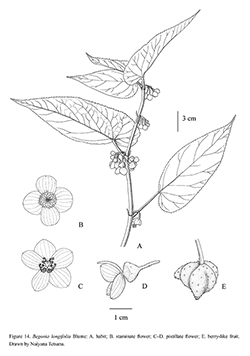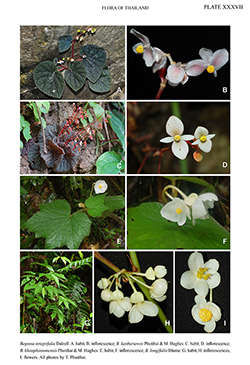e-Flora of Thailand
Volume 14 > Part 3 > Year 2019 > Page 396 > Begoniaceae > Begonia
27. Begonia longifolia Blumewfo-0000824620
[§ Platycentrum], Catalogus 102. 1823; Blume, Enum. Pl. Javae 1: 97. 1827; Candolle, Prodr. 15(1): 398. 1864; Koorders, Exkurs.- Fl. Java 2: 650. 1912; Tebbitt, Brittonia 55(1): 25. 2003; Tebbitt, Begonias 168. 2005; Kiew, Begonias Penins. Malaysia 107. 2005; Hughes, Annot. Checkl. SE Asian Begonia. 72. 2008; Camfield & Hughes, Eur. J. Taxon. 396: 58. 2018.— Diploclinium longifolium (Blume) Miq., Fl. Ned. Ind. 1(1): 687. 1856. Fig. 14. Plate XXXVII: G–I.
Accepted Name : This is currently accepted.
Synonyms & Citations :
Description : Monoecious caulescent subshrub, up to 2 m tall. Stems rhizomatous, creeping with numerous fibrous roots, aerial stem erect, succulent, dull dark green with nodes and internodes glabrous, internodes up to 20 cm long, 15−20 mm diam. Leaves distant; petiole pale green, 5−10 cm long, hispid, grooved above; lamina basifixed, succulent, asymmetric, papery when dry, adaxial surface dark green, hispid, abaxial surface densely hispid, pale green, oblong-lanceolate, 10−25 by 4−14 cm, base very unequally cordate, apex attenuate, margin serrate with echinate hairs, venation pinnate, midrib and lateral veins concolourous with lamina, veins 5–7, impressed above and prominent beneath. Stipules caducous, pale green, ovate-lanceolate, 10−15 by 2−4 mm, apex acute, margin entire. Inflorescences axillary, dichasial with 3 staminate and 4 pistillate flowers; peduncles pale green, glossy, terete, glabrous. Bracts caducous, membranous, pale green, ovate, 5−10 by 1−3 mm, apex acute, margin entire. Staminate flowers: pedicels pale green, 5−15 mm long, with a few minute, sparse echinate hairs; tepals 4, creamy white, outer 2 ovate to orbicular, 10−12 by 12−11 mm, base rounded, apex rounded, margin entire, glabrous on both sides, inner 2 obovate, 8−10 by 7−8 mm, base obtuse, apex rounded, margin entire, glabrous on both sides; androecium actinomorphic, subglobose, stamens numerous, bright yellow, filaments free, ca 2 mm long, anthers oblong, 1.5–2 mm long, dehiscing by longitudinal slits from base. Pistillate flowers: pedicels pale green, 10−15 mm long; tepals 5, creamy white, unequal, outer 2 orbicular, 10−12 by 8−10 mm, base obtuse, apex rounded, margin entire, glabrous on both sides, inner 3 obovate, 10−12 by 6−7 mm; styles 3, fused at base, yellow, twice spirally twisted, stigmatic band crescent-shaped; ovary 3-locular with a wing at centre of each locule, wings equal, placentae bilamellate. Fruit a fleshy berry, dull green, pendulous, drying brown, rhomboidal to spherical, ca 14−15 by 12−17 mm; wings triangular, 5−6 mm long, base 4−5 mm tall. Seeds brown, barrel-shaped.
Thailand : NORTHERN: Chiang Mai, Nan; PENINSULAR: Nakhon Si Thammarat, Surat Thani.
Distribution : India, Nepal, China, Myanmar, Vietnam, Malaysia, Indonesia (type, Java).
Ecology : On wet soil in deep shade by streamsides or on slopes in dry evergreen forests. Flowering: May–November; fruiting: November–January.
Vernacular : Som kung bok (ส้มกุ้งบก).
Notes: Vegetative specimens are nearly impossible to tell apart from Begonia acetosella. When fertile, they are easily separated as B. longifolia is monoecious, with 3-locular ovaries (not dioecious with 4-locular ovaries).


